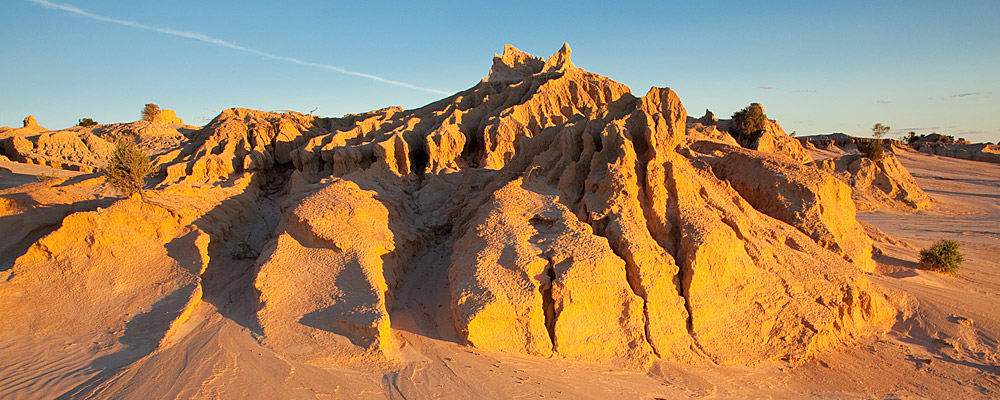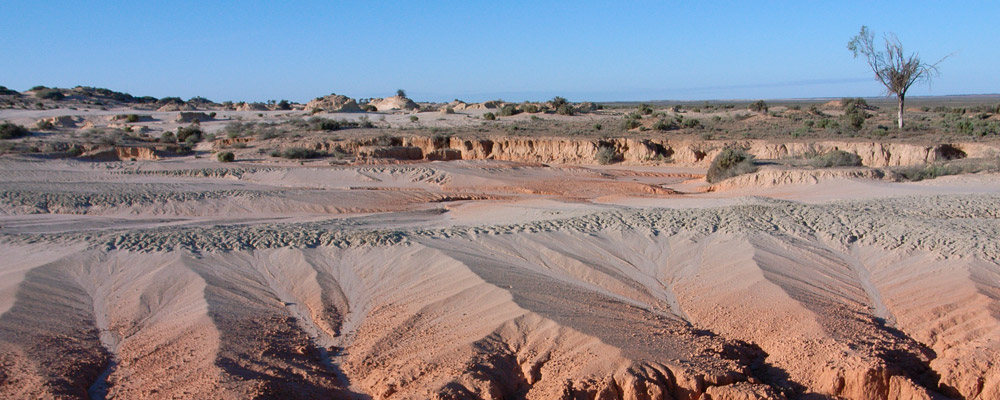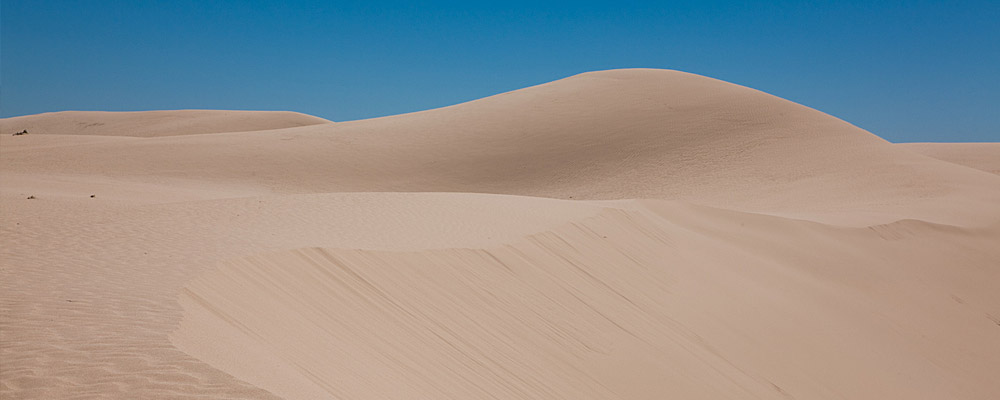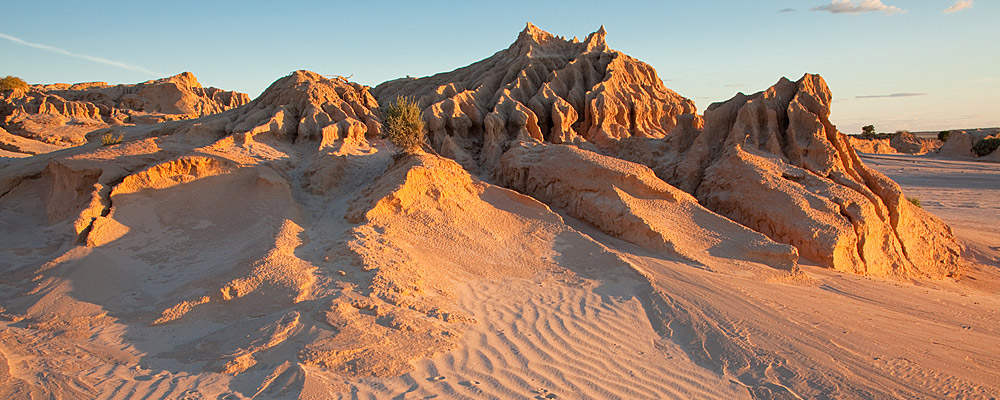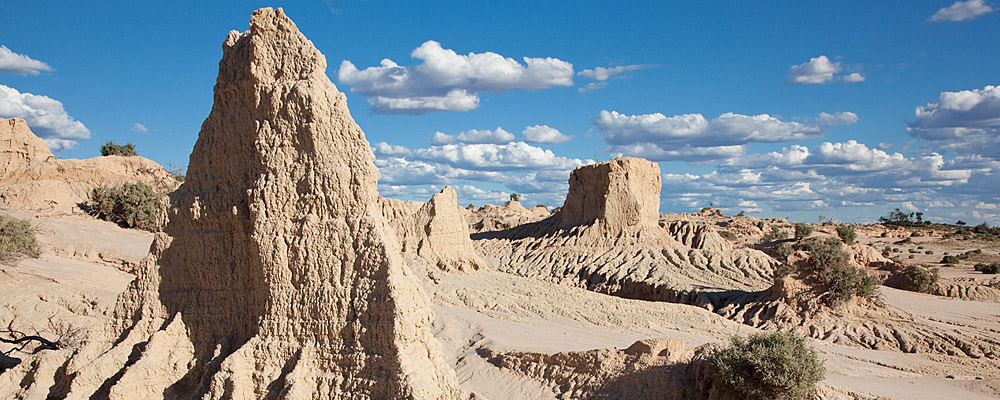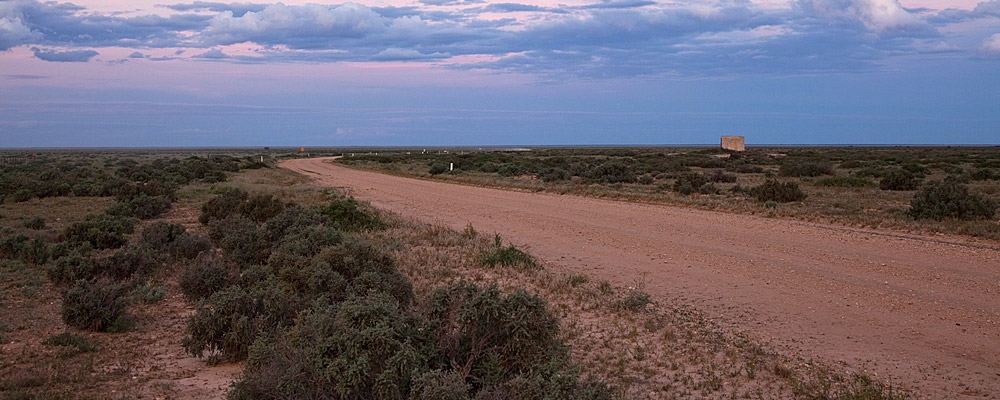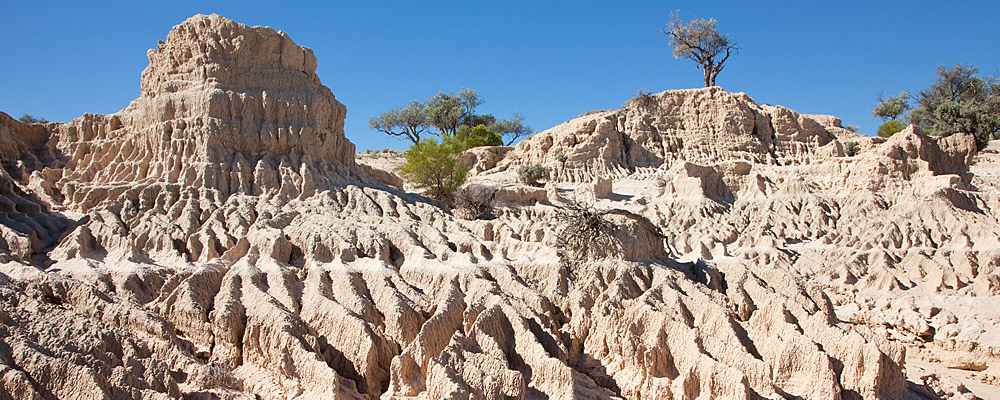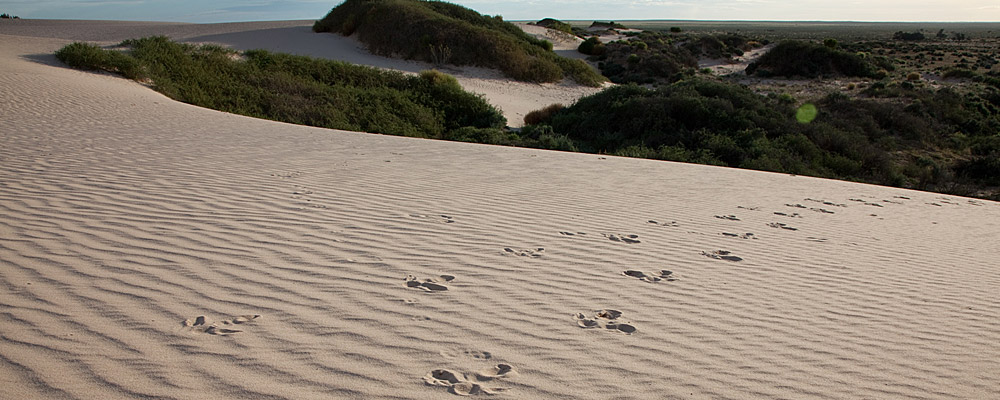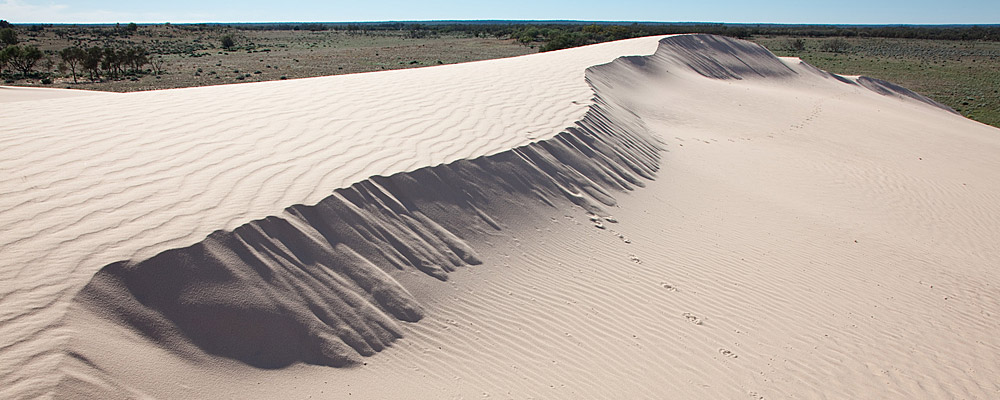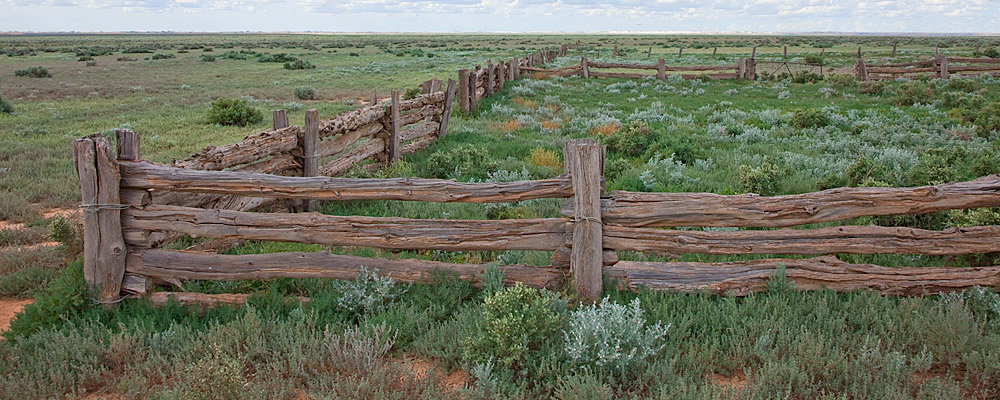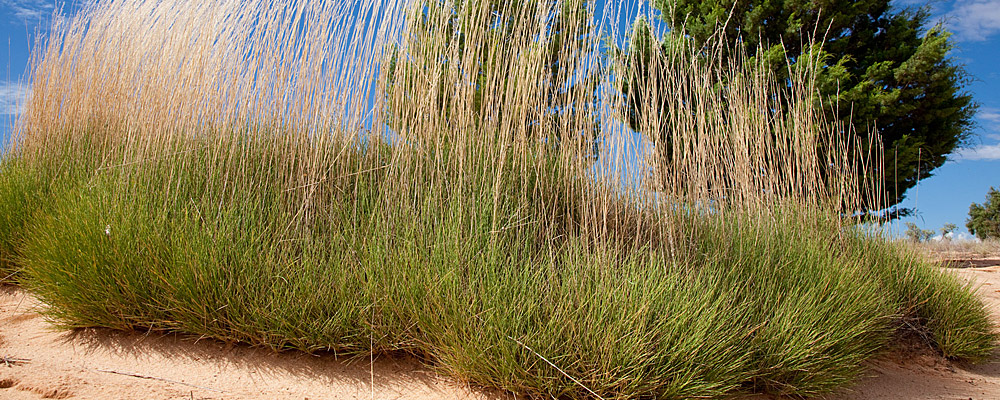Understand Mungo
Ancient Mungo Environments
A Mungo Timeline
This list describes the key climatic, environmental and human events that have affected Willandra Lakes in the recent geological past.
- Time BP
- Climate & Landscape
- Many millions of years ago
- Earth movements create the large, low-lying Murray Basin, where the Willandra Lakes lie today.
- 32 million years ago
- The sea floods the Murray Basin from the south and covers the area where Willandra Lakes form later.
- 6.5 million
- The sea begins a slow and halting retreat from the Murray Basin.
- 3 million to 1 million
-
The coastline nears its modern position, but earth movements block the ancestral Murray-Darling River near its mouth, causing a huge lake (Lake Bungunnia) to back up into the Murray Basin.
The large lake suggests a wetter climate than today. - 700,000
-
The Lake Bungunnia barrier is breached and the lake drains.
Active dunes form in central Australia and the mallee region of the western Murray Basin. - 150, 000 to 130,000
-
By 150,000 years ago the Willandra Lakes had formed and water filled the basins.
Low lunette ridges begin to develop on the eastern margins of the lakes, built up from sand blown off wave-formed beaches.
The Golgol layer forms the incipient Mungo lunette. - 120,000 to 70,000
- Water levels fall in Willandra Lakes during a relatively dry climatic phase.
- 75,000 to 60,000
-
Ice sheets expand across cooler parts of the globe, causing a fall in sea level.
Tasmania and New Guinea become joined to the Australian mainland.
The ocean gap between the larger Australia and the islands to the north shrinks to 120 kilometres. - About 60,000
-
The Willandra Lakes fill with water from the ancestral Lachlan River flowing down Willandra Creek, marking the onset of a period of abundant water in this part of Australia.
A period of full lakes, climate stability and biological abundance lasts for the next 20,000 years.
Lake Mungo is some 15 metres deep, with a surface area of about 200 square kilometres.
Dunes are vegetated and stable.
Woodland vegetation grows on the lunettes and lake surrounds.
The Lower Mungo layer is deposited on the Mungo lunette.
Sea level is some 40 metres below present.
The first human arrivals reach Australia across the sea gap from south east Asia, and spread across the continent. - About 55,000
- The first human arrivals reach Australia across the sea gap from south east Asia, and spread across the continent.
- About 45,000
-
The first human artefacts appear at Lake Mungo.
Some megafauna become extinct. - About 42,000
- Mungo Lady and Mungo Man are buried in the Mungo lunette.
- By 40,000
-
Water levels in Willandra Lakes fall and the lakes become salty.
Clay is blown over older sand lunettes. The Upper Mungo layer is deposited on the Mungo lunette.
People occupying the shores of the lakes, hunting, fishing and burying their dead. - 40,000 to 22,000
-
The climate fluctuates for 18,000 years.
Water levels in Willandra Lakes also fluctuate, going through several cycles of filling then drying out again.
Sand blows on to the lunettes during lake-full phases, and clay during dry phases. The Arumpo and Lower Zanci layers are deposited on the Mungo lunette.
Vegetation fluctuates along with the climate, with periods of abundance when the lakes are full.
Humans leave abundant evidence, including the remains of fish, shellfish and small mammals. They may feast on mass fish deaths in the drying lakes. - 22,000 to 18,000
-
The world enters a period of cooler climate, known as the Last Glacial Maximum. Icefields spread again across the northern continents. Sea level falls to 120 metres below present.
Australia turns cool, dry and windy. Glaciers grow around Mount Kosciuszko and in the Tasmanian highlands. Winter snowfields spread along the ranges. Temperatures are 6 to 9 degrees lower than today.
Plant and animal life are greatly diminished. Woodlands contract into grasslands and shrublands. The Murray Basin rivers are bare of trees.
Runoff and erosion from the highlands increases due to exposed ground. Fed by mountain snow-melt, the rivers carry high spring/summer flows and large amounts of sediment, but the Lachlan River shrinks back from the lakes and dissipates onto the barren plains.
Willandra Lakes gradually dry out, starting in the south and moving progressively north. Groundwater levels remain high for a time, but the lakes never fill again.
Sand dunes are devegetated and become mobile, moving in around the lakes from the west. Cold winds blow sand and dust-storms.
Clays are blown from drying lakes onto the lunettes. The Upper Zanci layer is deposited on the Mungo lunette.
Humans leave some evidence, including footprints on a moist claypan. People probably move northwards along the lakes, following the fish and shellfish as the water retreats and food resources diminish under harsh conditions in the wider landscape. - 18,000 on
-
The worldwide ice age begins to thaw. Sea level rises, rainfall increases and vegetation greens the landscape again.
Conditions improve at Willandra Lakes, but the climate remains relatively dry. Vegetation slowly returns to become similar to what it is today.
Humans leave some evidence of their presence. - 12,000
-
Rivers take on their current smaller form.
Trees return to the banks of the western rivers.
Sea level approaches its current level. - 10,000 to present
-
The ice age is well and truly over. A relatively stable, semi-arid climate settles over Willandra and continues to the present.
The Lachlan River abandons the Willandra Creek channel and flows down the modern Lachlan channel.
The water table at Willandra Lakes falls, switching off the wet-dry lunette-building cycle so the lunettes stop growing.
Vegetation expands somewhat and erosion is reduced. Dunes become stabilised.
Thylacines and Tasmanian Devils become extinct and Dingoes arrive, on mainland Australia and in the Willandra area.
Humans leave intermittent evidence of their presence. - The last 200 years
-
Europeans arrive in the Willandra Lakes area in the 1840s, bringing sheep and cattle. Rabbits arrive about the 1880s.
Vegetation is reduced and changed by grazing of introduced mammals.
At the end of the 1800s, overgrazing and severe drought combine to shock the ecosystem. The productivity of the environment plunges lower than it has been for 10,000 years, and stocking rates never recover.
Hairy-nosed Wombats, bilbies, bettongs and other small to medium sized native mammals are driven to extinction.
Lunette erosion, which commenced before white settlement, is accelerated by grazing. Archaeological relics are exposed.
Aboriginal people are dispossessed of their traditional lands but work in the early days of the pastoral industry.
Mungo National Park is reserved in 1979 and later expanded.
The Willandra Lakes Region is listed as a World Heritage Area in 1981.
Aboriginal people increase their presence again in the Willandra Lakes area.

